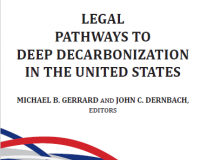
Vibrant Environment
Governance And Rule Of Law
All | Biodiversity | Climate Change and Sustainability | Environmental Justice | Governance and Rule of Law | Land Use and Natural Resources | Oceans and Coasts | Pollution Control

Carbon capture and storage (CCS) is a hot-button topic as a strategy to mitigate climate change and reduce greenhouse gas emissions. CCS entails capturing carbon dioxide from the atmosphere and industrial plants at the source, then injecting the captured carbon dioxide into underground geologic formations for storage. Much research has focused on sequestering carbon dioxide onshore, in depleted oil and gas reservoirs or deep saline aquifers. Offshore CCS also may be feasible, but presents several governance and legal challenges.

Frustrated by some states’ use of their Clean Water Act (CWA) §401 authority to oppose or delay energy projects—particularly the transportation of fossil fuels—the Trump Administration issued the second installment in its efforts to restrict that authority on June 7. The U.S. Environmental Protection Agency’s (EPA’s) Clean Water Act Section 401 Guidance for Federal Agencies, States and Authorized Tribes strictly interprets state deadlines under §401 and takes a narrow view of the grounds on which states may deny or condition their approval of projects. The guidance follows an April 10 executive order, and will be followed in August by proposed EPA rules, with final rules by May 2020.

Several cases before the U.S. Supreme Court this term touched environmental law, ranging from jurisdictional disputes over a state’s right to ban uranium mining to whether state or federal laws apply when hunting moose from a hovercraft along an Alaskan river. An unusual amount of cases navigate the intersection of environmental regulations and tribal sovereignty, the Court so far siding with tribes on the issues of state fuel tax exemptions and hunting rights. One pending case, Carpenter v. Murphy, is not explicitly environmental, but the answer to its core question has potentially seismic environmental implications: is the eastern half of Oklahoma still, technically, an Indian reservation? While the case primarily involves criminal jurisdiction, the degree to which the Court accepts or rejects this question may alter taxation, regulation, and even ownership of one of the most energy resource-rich regions in the country.

With the help of the U.S. Congress, the U.S. Department of the Interior (DOI) has had a long and proud history of tackling pressing challenges through responsible and inclusive management of America’s public lands. One might expect it would continue that tradition as climate change has become a major challenge confronting the nation.

Women have been leaders in every major movement, though their contributions all too often go unrecognized. The environmental movement is no exception. Women striving toward the betterment of this field have faced many challenges, but through skill and determination, they persevered. The environmental movement is over two centuries long with generations of women shaping policies and laws within the field. This blog features just a handful of the numerous women who paved the way for future environmentally conscious generations.

In 2018, the Council on Environmental Quality (CEQ) announced its intentions to revisit and revise its 40-year-old NEPA regulations, following Pres. Donald Trump’s call in Executive Order No. 13807 to modernize the environmental review and authorization process. CEQ issued an advanced notice of proposed rulemaking last June and is now expected to send its proposal to the White House shortly.

Many have argued that gender equality and women’s empowerment are essential to advancement in many areas of life, such as business, health, and education. This brief blog post posits that the field of sustainable development and environmental protection are no different. Gender equality and, more particularly, women’s empowerment, are critical to achieving sustainable development across the globe. It is not a one-size-fits-all proposition, and the gender differences and deeply rooted policies that perpetuate inequality differ from region to region.

Any self-respecting environmental lawyer knows, 2019 marks a major anniversary for environmental law: the Cuyahoga River fire of 1969. While we note the anniversary today, I doubt onlookers in Cleveland appreciated at the time that it would give rise to a five-decade era of environmental lawmaking.

In ways that did not exist even ten years ago, everyday people are acting as scientists: contributing their time and data to make notable discoveries, answer lingering questions, and develop awareness. Motivated by technology innovations, public concern, and limited institutional capacity, citizen science is gently reshaping the conventional systems that address human health and environmental protection.

“For everything there is a season,” says the old Pete Seeger song, quoting the much older still book of Ecclesiastes. It seems that we are currently in the season of walls. The physical manifestation of this particular period may be the issue of the wall on our southern border. But there are other walls, and some of them have law as their concrete or steel.